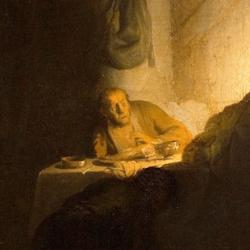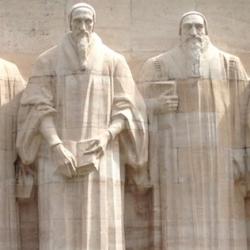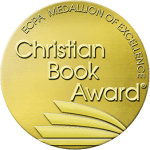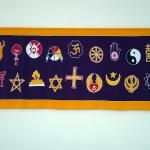Hughes Oliphant Old is the dean of Reformed liturgical scholars, and he has crowned his career with the publication of a massive (900+ pages) study of Holy Communion in the Piety of the Reformed Churches.
The title is significant: Old is interested in Eucharistic piety and practice as much as Eucharistic theology (and, contrary to some sectarians, “Eucharist” has long been a standard Reformed term). He draws not only on theological treatises, but also and even especially on liturgical texts, catechisms, sermons, devotional guides.
Though Old insists that the Reformed tradition is more than Calvin, he devoted the first 180 pages to Calvin’s theology and practice of the Supper. Then his book takes off as he examines early Anglican, Scottish, Puritan, Swiss, Huguenot, Dutch, and American writers from the Reformation through early nineteenth century. His treatment of the past two centuries is sketchier, but Old provides welcome chapters on Henry van Dyke and the Book of Common Worship on his Doktorvater, J-J von Allmen.
Inevitably, there is some repetitiveness; formulas, terms, illustrations get repeated across the tradition, which is what makes it a tradition. Old’s book reads like a set of reading notes, flecked with breezy first-person asides. Old stresses the continuity of the tradition, and his criticisms of individual writers and concepts is reserved and generous. He is gentle with Zwingli, especially his early work, and argues that “memorial” deservedly has a place in Reformed sacramental theology, albeit not alone. He faults a number of Eucharistic prayers (Baxter’s, for instance) for not following the biblical model of providing “hymnic” recitations of redemptive history. He doesn’t think that Hodge took enough time in his review of Nevin’s Mystical Presence. He argues that “fencing” the table has sometimes cancelled the invitation that should accompany it. He is worried that the twentieth century Reformed churches have largely forgotten this heritage. He claims that “intinction mangles the original shape of the covenant meal” because it interrupts the sequence of prayers that is “essential to its nature” (862-3).
A few highlights. In his chapter of Bullinger, Old emphasizes that Zwingli’s successor enriched Zwingli’s theology of communion, developing something far more than “mere memorialist.” In Affirmation 198 of the Second Helvetic Confession we read that “as bodily food and drink not only refresh and strengthen our bodies, but also keeps them alive, so the flesh of Christ delivered for us, and his blood shed for us, not only refresh and strengthen our souls, but also preserve them alive, not in so far as they are corporeally eaten and drunken, but in so far as they are communicated unto us spiritually by the Spirit of God” (quoted 321).
In a lengthy summary Meditations composed by the moderate Puritan Edward Reynolds, Old quotes this striking claim: “the end of eating is the assimilation of our nourishment, and the turning of it into our own nature and substance: whatsoever cannot be assimilated, is ejected: and thus is it between us and Christ” (quoted 338). This Thomistic comment sounds a lot like Christ becomes incarnate not in bread but in us bread-eaters. Like most Reformed writers on the subject, Reynolds emphasizes union with Christ as the central blessing of communion, but he does so beautifully: “We so often read of the inhabitation of Christ in his church; of his more peculiar presence with, and in, his people; of our spiritual ingrafture into him by faith; of those more near and approaching relations of brotherhood and coinheritance between Christ and us; that mutual interest, fellowship, and society, which we ahve to each other; with infinite other expressions of that divine and endless mixture, whereby the faithful are, not only by a consociation of affections and confederacy of wills, but by a real, though mystical, union” (quoted 339).
John Willison, an eighteenth-century Scottish pastor found Eucharistic overtones in eroticism of the Song of Songs. Old writes, “One notices . . . how important the Song of Solomon and the uptial imagery of both the Old and New Testaments is in Willison’s sacramental sermons,” a connection that is very common throughout the sixteenth and seventeenth centuries. “Like the spouse in the Song of Solomon who sought her beloved all about the city,” Willison writes, “In all duties and ordinances, both private and public, our souls should follow hard after him, and pursue him closely, as it were, from one ordinance to another” (quoted 479).
One of the recurrent liturgical issues in Reformed history has been the question of appropriate posture at the Lord’s Supper. In a sacramental catechism of 1720, Willison advocates a seated posture as being the appropriate “feasting-posture<” since the Supper is “a blessed love-feast wherein he treats his people as his friends and intimates” (quoted 514-5).
Old has produced a work of enduring value. Anyone who wants to study Reformed sacramental theology will want to start here, and with Old’s earlier study on the The Shaping of the Reformed Baptismal Rite in the Sixteenth Century. Holy Communion will silence anyone who thinks there is no Reformed tradition of Eucharistic piety and reflection, and not just because it’s big enough to knock someone out cold.














